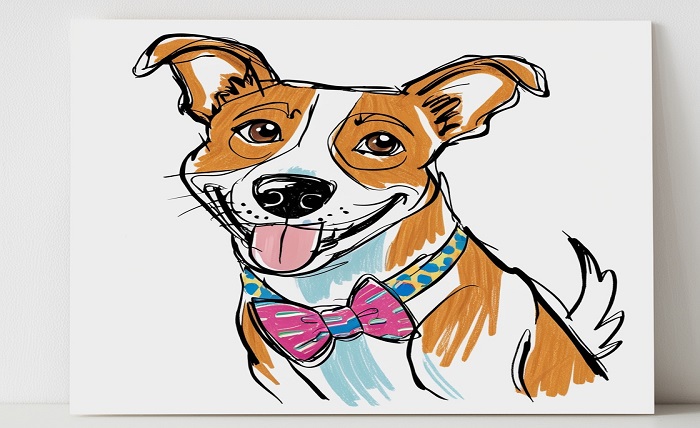Since dogs have long been considered to be among the most cherished human friends, it should come as no surprise that many artists attempt to depict their devoted, affectionate, and playful personalities in their works of art. It may be very satisfying to grasp the subtleties of dog drawing, regardless of whether you’re an amateur artist hoping to learn how to do it or an accomplished sketcher hoping to improve your methods. Everything you need to know about drawing dogs will be covered in this extensive tutorial, from fundamental methods to specific suggestions for producing realistic and expressive dog portraits.
Knowing the Anatomy of Dogs to Draw
Knowing the fundamentals of a dog drawing is crucial before you start drawing. You can sketch them more realistically and convincingly if you understand how their body parts move and are proportioned.
Dogs vary widely in size and shape: but the most have similar proportions. The head, neck, and body are the three main parts of a dog’s body. You can create more realistic sketches if you are aware of these proportions.
Skeletal Structure: The skull, spine, ribs, and limbs make up a ddog drawing. It will be easier to comprehend the dog’s posture if you know how these bones move and join.
Crucial Drawing Instruments for Dog Illustrations
When making a successful dog drawing, having the appropriate equipment is crucial. The following are the necessary supplies to get you started:
Pencils: For different phases of your dog drawing, a variety of pencils, ranging from H (hard) to B (soft), are best. Soft pencils work better for shading and giving depth, whereas hard pencils work well for light outlines.
Erasers: If you wish to lighten regions that need refinement or soften lines, a kneaded eraser is ideal. Sharper, more thorough corrections can be made with a precision eraser.
Paper: To assist retain pencil markings when sketching, use medium-weight paper with a hint of texture. Smoother sheets will let you add finer work for final shading and detail.
Selecting the Appropriate Reference Picture
Choosing a high-quality reference image is essential to producing a realistic dog drawing. Take into account the following factors when choosing an image to work from:
Clear Visibility: Verify that there is no blur and that the image is sharp. You can catch delicate details by taking clear pictures of the dog’s face or profile.
Lighting: It is best to have natural lighting. Choose a picture where the dog drawing features are clearly seen due to the light source, free of harsh shadows or overexposed areas.
Breed Features: If you’re sketching a particular breed, make sure your reference image emphasizes the breed’s most distinctive features, like the coat texture, nose, tail, and ear shape.
tep-by-Step Guide to Drawing a Dog
It’s crucial for novices to divide the task of dog drawing into smaller, more doable parts. Use this easy guide:
Let’s start with the fundamental shapes: Start by illustrating the dog’s basic outline using light circles for the head and torso. To determine the dog’s position, draw lines for the legs and tail.
Define the Head and Body: After you have the fundamental outlines, begin to refine the outline by drawing the dog’s limbs, face, and ears. Take note of the breed’s distinctive characteristics, such as its small legs and long ears.
Add facial: features by drawing the mouth, ears, nose, and eyes. Take your time and make sure the features are as realistic as you can because this is where the dog’s personality shines through.
How to Sketch Particular Dog Breeds
Understanding how to depict the distinctive qualities of several dog drawing is crucial. Here’s how to sketch several well-known dog breeds:
Labrador Retriever: The Labrador’s powerful frame and wide face necessitate particular attention to the head and leg shapes. Pay attention to their kind smile and soft eyes.
German Shepherd: Distinguished by their sharp ears and powerful, nimble physique, German Shepherds need their muscular structure and fur to be maintained in a sleek manner.
Poodle: To depict the texture and volume of its coat, the poodle’s long, flowing strokes require meticulous attention to detail.
Conclusion
dog drawing is a fun and fulfilling hobby that blends creativity, patience, and observation. Regardless of your level of competence, using the methods described in this article will help you improve and create beautiful canine artwork. You can depict the beauty and individuality of dogs in your drawings by concentrating on their anatomy, fur texture, and distinctive traits.
FAQ
Which pencil works best for drawing dogs?
You can handle both fine details and dark shadows with a solid selection of pencils, such as 2H for light drawing and 6B for shading.
How much time does it take to become a proficient dog artist?
Your skill level and practice time will determine how long it takes you to learn. Within a few weeks of consistent practice, you should notice a discernible improvement. Read more information: dog drawing
Is it possible to sketch a dog from a picture?
Indeed! One of the finest methods for dog drawing is to use a reference photo. Make sure the image is crisp and captures the dog’s details.

